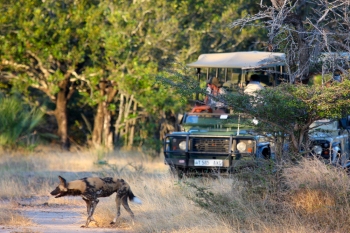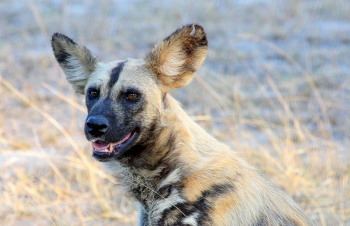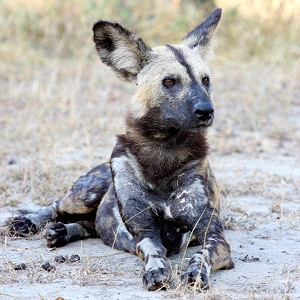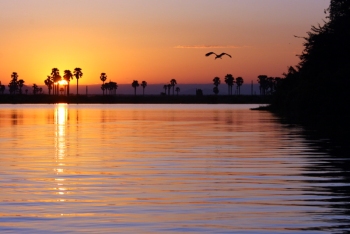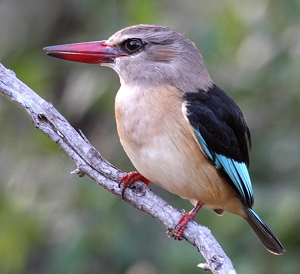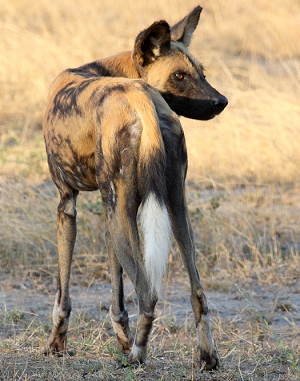- You are here
- Home
- Guide to Africa
- African Travel Articles
- Selous Impala: Where Going to the Dogs Is a Good Thing
Selous Impala: Where Going to the Dogs Is a Good Thing
Parent page
Written by Steve Brynes - The Safari Advisor
African Wild DogDennis Mchopa and I sat in our safari vehicle, a pack of four African wild dogs just a few feet away. Two of the dogs were extended on their sides already sleeping, the other two sitting, panting, their eyes opening and closing as they fought the languor brought on by the combination of a failed hunt and the morning's rapidly warming air.
Dennis extended his arm and whispered, "Do you see that female? Last year she gave birth to several pups. But when she and her pack returned from hunting one day, the den was empty. We believe pythons took her pups. For a long time, she hardly ate or hunted, and she grew weak. We were afraid we would lose her. Fortunately, she made it."
At the risk of being tagged an anthropomorphist (one who attributes human behavior to animals), I took the mom's behavior as a sure sign of profound grief. After repeated trips to Africa, I've come to agree with Dutch primatologist and ethologist Frans de Waal's sentiment that "To endow animals with human emotions has long been a scientific taboo. But if we do not, we risk missing something fundamental, about both animals and us."
African Wild DogAnd if any destination can more readily elicit something fundamental in us than Africa, I've yet to find it. The French termed it mal d'Afrique, an indefinable feeling of loss that compels visitors to return to Africa time and again. Theories about the cause abound: it is a taste for dust; it is the alteration of one's vision, the sense that you've stepped into a place of endless pristine wilderness; it is the feeling of detachment, your spirit telling you you've found a place to linger; or maybe it is your inner being recognizing the birthplace of its origin.
One thing is certain: much like the common cold, there is no cure and the best you can do is to treat the symptoms. And, so it was that, seeking some relief, I made last-minute plans to head back to Africa.
There were any number of options for an African safari: South Africa's Kruger National Park and the adjoining Sabi Sand, Tanzania's Serengeti, Kenya's Masai Mara, or Botswana's Chobe and the Okavango Delta. There's no question that those places belong in Africa's game viewing Hall of Fame, their iconic names alone evoking mental images of big cats inexorably stalking prey, monstrously huge crocodiles clamping their powerful jaws on unsuspecting zebra or wildebeest at river crossings, and bloody-muzzled hyenas cleaning up the remains of kills, filling the air with the eerie sound of bones being pulverized.
But I chose the destination less traveled, in fact much less traveled, and headed to Selous Game Reserve in Tanzania's Southern Circuit.
The Southern Circuit of Tanzania includes the national parks of Mikumi, Katavi, Ruaha and Saadani. But the centerpiece is Selous (pronounced Sel-oo), at 17,757 sq. miles the largest game reserve in Africa (however, only 5% of this area is game-protected, with the other 95% carved into hunting concessions). In a country that boasts the Serengeti, Lake Manyara, the Ngorongoro Crater and Mt. Kilimanjaro (i.e., the Northern Circuit), the Southern Circuit attracts only about 1% of the tourist trade in Tanzania. As a result, those who go south will find one of Africa's most alluring and satisfying safari destinations refreshingly untrammeled. Game viewing will be done in the absence of numerous, possibly noisy, vehicles, an unfortunate reality of the higher profile safari destinations, and, given Selous' five lakes and Rufiji River, a fair amount of the game viewing and bird watching can be done from the water.
Although the reserve hosts the usual wildlife one would hope to see on safari (though Cheetah, which require wide-open plains for hunting, won't be found) it was the high probability of seeing wild dogs that drew me to Selous. It had been roughly five years since last I'd seen wild dogs, one of Africa's greatest predators and, owing to their endangered status, one of the most difficult to spot on safari.
African Wild DogExperts believe that fewer than 5,000 African wild dogs (Lycaon pictus, commonly known also as the Cape hunting dog or the painted hunting dog) currently exist in the wild, and their range has declined from 33 to 15 countries. Once, African wild dogs numbered in the hundreds of thousands and were common in virtually every environment in southern Africa except rain forests and deserts. But human encroachment has drastically reduced their range and their numbers. They have been widely regarded as pests; consequently, they've been poisoned, shot, and trapped in many areas. Perhaps their most serious threat, though, is introduced diseases. Burgeoning human populations have brought the African wild dogs into frequent contact with domestic dogs, many of which carry canine distemper, parvovirus and rabies. These diseases are ravaging the wild packs
Selous is thought to have up to 1300 individuals, double that of any other African country and approximately 20 to 30% of the global population. Once I'd considered that statistic, the choice of destination was a slam-dunk.
Selous is a vast, thriving wildlife area of forests and woodlands around the lagoons, sandbanks and lakes of the Rufiji River, the lifeblood of the reserve, whose waters attract elephant herds and are packed full of grunting hippopotami and yawning crocodile. The terrain varies from rolling grassy woodlands and plains, to rocky outcrops cut by the Rufiji.
Selous SunsetI arrived at the Selous Impala Camp shortly after noon, giving me to time to grab some lunch and then settle in to the luxury tent before starting my afternoon activity. Situated on the banks of the Rufiji, and having only 8 tents and a 'mascot' hippo named Andrea who often comes by at night to graze while visitors dine, the camp screams, "This is how an African safari should be."
In addition to the usual game drive, Selous offers activities not usually available in many safari destinations: fly-camping, boat safaris, walking safaris (with an armed Tanzanian Ranger) and fishing outings with large catfish and powerful tiger fish the main targets. Knowing that I would spend almost all my time during my stay on game drives, I opted to forego the first day's afternoon game drive for a water safari.
Daimon Mwehanga met me at the dock and helped me board the small, flat-bottom boat. He pushed off, then headed upstream as the waters of the Rufiji, swollen and slightly brown after the heavy rains that began in March and ended in May, hurried past us. Moving slowly against the rushing river, we had time to admire the heavy greenery, dotted with red and yellow flowers, lining the banks. So thick was the foliage that occasionally the trees could be seen to be whipped about madly, but the elephants causing the commotion remained unseen. Hippos kept a wary eye on us and crocodiles, mostly in the small to medium range, scampered off the sandy embankment at our approach.
Arguably, though, the most memorable aspect of a water safari is the profuse birdlife, making Selous a birder's mecca. Yellow-billed storks, skimmers, heron and other waders, plovers, pelicans, and fish eagles (similar to our bald eagle) are likely sightings. Along the banks colonies of white-fronted bee-eaters nest in holes, while pied and malachite kingfishers dart to and fro. As dusk deepens and the boat heads for home, you are treated to a dreamy sunset.
Selous KingfisherOn the first full day out, game viewing, at least concerning predators, was slow: we saw a single hyena that wanted no part of us and steered away. (Many animals in Selous actually were skittish and kept their distance. Seeing wildlife less habituated to people than in the major safari destinations, while it sometimes meant not getting as close as desirable for photographic purposes, was refreshing.) Luckily, Selous, with its approximate 350 species of birds, offers outstanding birding and I busied myself photographing some eye-catching specimens. But after 6 hours of driving there had been no sign of the primary reason I'd come to southern Tanzania, the African wild dog.
Dennis looked at me and could easily read the disappointment in my face.
"You're at our camp another four nights, am I right?" I nodded. "Then I can say with 100% certainty that you will see dogs." At "100% certainty" the words "death" and "taxes" flashed through my mind, but who was I to argue with somebody who, a camp manager had told me the night before, had an uncanny and unmatched knowledge of the reserve?
African Wild DogOn the following morning, after 3 hours of driving, Dennis exclaimed, "Dogs. To the right!" I turned in time to see one bounding through the bush, apparently in pursuit of prey. With keen instinct, Dennis anticipated the dogs' path, circumvented the impassable bush and several minutes later, in a small clearing, caught up with the dogs, which now had dropped to the ground. About the size of a German shepherd, but leaner, the dogs could be seen to have long legs, large ears and mottled fur of browns, black and white. After relating the sorry fate of the pack's pups and spending time watching the dogs drift off, Dennis said, "Can we leave now and let them sleep? We know where they are and we will return late afternoon to follow them in a hunt."
Word in the bush spreads with gazelle-like speed, so, although most of our game viewing until now had been done without other cars around, by the time we arrived back in the late afternoon, the pack was surrounded by about 5 or 6 cars. As the dogs roused themselves, they appeared impervious to us, apparently putting on their game faces for the hunt. Hunting in packs, wild dogs are efficient hunters. Using speed and incredible endurance, they are said to be successful about 80% of the time (compared to 30% for Lions).
With a human caravan in tow the dogs began to move, fanning out and stopping from time to time to rotate their long ears in various directions and to hold their noses high. Using their keen senses, the dogs were trying to locate impala. After several starts and stops, the pack broke into a full run through the heavy bush. Again relying on instinct, Dennis broke away from the other safari cars and drove to where he thought the dogs would emerge from the heavy growth. About ten minutes later, the dogs burst from the bush and stopped abruptly: they had lost their prey.
"At this time of year the bush is very thick, which plays in the favor of the impala. They use the bush to hide and the dogs lose track of them. They haven't eaten today." As dusk began to fall heavily, we watched the dogs, heads down, trod forlornly down the dirt road in single file, probably looking for a place to bed down for the night.
On the last game drive of my stay the radio crackled and after a brief conversation, Dennis told me that a pack of dogs had taken down three impala. We made the short drive to the kill site, only to learn that a pride of lions had arrived a few minutes before us, driving away the dogs before they could entirely consume the impala.
We watched as the lions cleaned up the remains. After finishing off part of the carcass, a large male lion pranced through the grass with an impala leg in his jaws. Not to be outdone, or perhaps just trying to impress the pride's leader, a cub followed suit, parading around with his own impala leg.
Watching this scene unfold in Selous' pristine wilderness, I was reminded of one thing. Despite my enthusiasm for wild dogs and their position at the top of so many safari goers' wish list, in Africa, as in so many other venues, "It's good to be the king."
